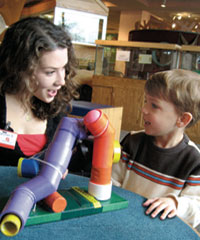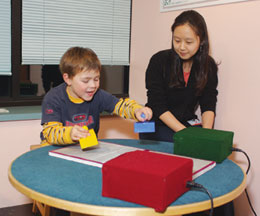Presidential Column
Day At The Museum
One of the themes of my work this year has been to encourage psychological scientists to actively engage in improving the public understanding of our science. On one end of the spectrum is the APS Wikipedia Initiative, which we’ve launched in order to improve the quality of information about psychological science in the world’s most widely viewed online encyclopedia. This month’s guest column presents an innovative approach by directly engaging the public in creating new knowledge. The process benefits the science and gives back by education of psychological science through research participation and discussion. The work in the Boston Museum of Science, an imaginative place that I am affiliated with as well, illustrates ways in which scientists can capitalize on the universal fascination with human behavior to increase awareness of research methods and discoveries while showing children and their parents about the relevance of psychology to their daily lives.
-Mahzarin R. Banaji
APS President
Guest columnists Susan M. Letourneau and Lisa Feldman Barrett
In the movie “Night at the Museum,” exhibits only come to life when no one is around. But a unique research program at the Museum of Science in Boston is bringing psychological science to life for visitors by involving them as collaborators in the research process.

Lisa Feldman Barrett

Susan Letourneau
The museum’s Living Laboratory program — in which psychological scientists from multiple laboratories across the greater Boston area conduct studies within hands-on museum exhibits — benefits researchers, museum educators, and the general public and allows scientists to incorporate professional development and outreach activities into the very process of conducting their research. Museum visitors are able to contribute to ongoing studies and have one-on-one conversations with working scientists. By recruiting participants in informal educational environments, scientists are able to collect data and educate the public simultaneously. As part of the program, scientists also work closely with museum educators to learn how to interpret their research questions and methods for the general public, and in the process, museum educators learn about current research topics.
The Interdisciplinary Affective Science Lab (IASLab) at Northeastern University is a long-term collaborator with the Living Laboratory, conducting a variety of behavioral experiments on a range of topics relating to emotion perception (e.g., how contextual information, including conceptual knowledge, is integral to normal emotion perception), as well as the effect of people’s own affective reactions on their visual experiences. Lab members set up their experiments within Museum of Science exhibit halls, inviting museum visitors to play computer games involving morphed faces, flashing words, and other visual stimuli. Over the past two years, the IASLab has recruited a large and diverse sample of participants across a wide age range, from school-aged children through senior citizens, and has collected a rich data set on the perception of emotion. By conducting these studies in the Living Laboratory, they are able to bring new research findings to the public in an immediate and hands-on way.
Many members of the IASLab, including lab manager Janine Vlassakis and a host of postdoctoral fellows and students at all levels, have become deeply involved in the educational mission of the Living Laboratory. Members of the IASLab tailor the presentation of their research to suit the museum’s many audiences, who come from a variety of educational and cultural backgrounds. IASLab members have used feedback from the public and from museum staff to develop lay explanations of their research questions and to provide real-world examples of the relevance of psychology in daily life. IASLab members have also worked with staff at the Living Laboratory to adapt their research methods into interactive museum activities and have created educational visual demonstrations of previous research studies.
 In recognition of its dedication to this mission, the IASLab received the “Education All-Star Award” for members’ engaging and accessible interactions with museum visitors in the 2009–2010 academic year. The IASLab has also used its experience with the Living Laboratory as a jumping-off point for other outreach efforts, taking activities fine-tuned at the museum to classrooms around the Boston area as well as to community science festivals. At one recent festival (the USA Science and Engineering Expo in Washington DC, October 2010), IASLab members used these activities as a way to speak with over 1,000 visitors about their research on emotion.
In recognition of its dedication to this mission, the IASLab received the “Education All-Star Award” for members’ engaging and accessible interactions with museum visitors in the 2009–2010 academic year. The IASLab has also used its experience with the Living Laboratory as a jumping-off point for other outreach efforts, taking activities fine-tuned at the museum to classrooms around the Boston area as well as to community science festivals. At one recent festival (the USA Science and Engineering Expo in Washington DC, October 2010), IASLab members used these activities as a way to speak with over 1,000 visitors about their research on emotion.
Since the Living Laboratory’s inception in 2005, many psychology labs in the Boston area have taken advantage of the opportunity to reach the public. In addition to the IASLab, current Living Laboratory collaborators include the Laboratory for Developmental Studies and Paul Harris Lab at Harvard University; the Early Childhood Cognition Lab and Kanwisher Lab at MIT; the Emotion Development Lab, Arts & Mind Lab, and Infant & Child Cognition Lab at Boston College; and the Social Cognition and Social Psychology Labs, Interpersonal Perception & Communication Lab, and Department of Public Health and Family Medicine at Tufts University. Together, these laboratories bring a rich variety of topics in psychological science to the public, ranging from math and language cognition to social skills like sharing and altruism.
 For scientists, conducting psychology experiments in a science museum provides opportunities not only to translate and disseminate research questions and results but also to educate the public about the field of psychological science itself. Through informal education, participating labs increase museum visitors’ appreciation for our scientific discipline. For example, in addition to describing their research questions to the public, members of the IASLab highlight their research methods and experimental designs, providing information about how psychology research is conducted. The ongoing experiments in the museum offer hands-on examples of the research done by psychological scientists, perhaps even sparking young visitors’ interest in psychological science as a career path.
For scientists, conducting psychology experiments in a science museum provides opportunities not only to translate and disseminate research questions and results but also to educate the public about the field of psychological science itself. Through informal education, participating labs increase museum visitors’ appreciation for our scientific discipline. For example, in addition to describing their research questions to the public, members of the IASLab highlight their research methods and experimental designs, providing information about how psychology research is conducted. The ongoing experiments in the museum offer hands-on examples of the research done by psychological scientists, perhaps even sparking young visitors’ interest in psychological science as a career path.
The Living Laboratory program is a terrific example of how psychology researchers can increase the public’s understanding of psychological science by working with science museums, children’s museums, and other educational institutions. It is also a model that can be applied in other communities. Finally, this type of collaboration can contribute to the advancement of psychological research itself, while bringing current research topics to the public in new and innovative ways.




APS regularly opens certain online articles for discussion on our website. Effective February 2021, you must be a logged-in APS member to post comments. By posting a comment, you agree to our Community Guidelines and the display of your profile information, including your name and affiliation. Any opinions, findings, conclusions, or recommendations present in article comments are those of the writers and do not necessarily reflect the views of APS or the article’s author. For more information, please see our Community Guidelines.
Please login with your APS account to comment.